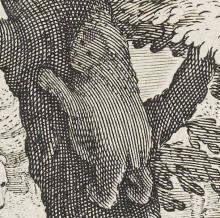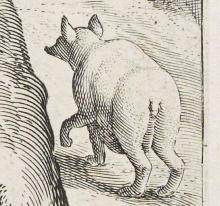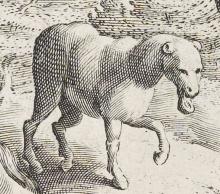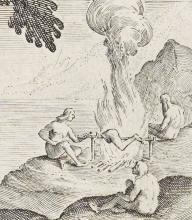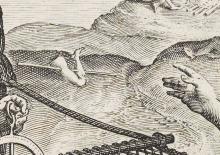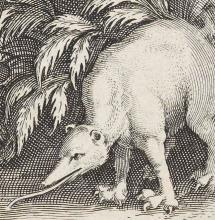
I. America
Commentary
Both sexes live absolutely naked and in a state of nature [...] The Spaniards found birds boiling in their pots, also geese mixed with bits of human flesh, while other parts of human bodies were fixed on spits, ready for roasting [...] Before the Spaniards had time to protect themselves with their shields, one of our men, a Galician, was killed by a woman, and another was seriously wounded by an arrow shot by that same woman [...] There was one woman amongst these savages whom, as nearly as could be conjectured, all the others seemed to obey, as though she was their queen.
Peter Martyr, De Orbe Novo, 1504 (trans. F.A. MacNutt, 1912, vol. I, 61, 75)
In this plate, Stradanus portrays the discovery of America as an encounter between two worlds. On the left is the Old World, portrayed by Amerigo Vespucci (1451-1512), the Florentine navigator who gifted us the name of the continent. He is shown clad in steel with his sword at his side, carrying an astrolabe in his left hand and a standard with the Southern Cross on the right (see cover commentary for this symbol). Behind him are two galleons, the ships that facilitated the discovery.
On the right, and around Vespucci, is the New World, embodied by the American 'Amazon' or cacica (chieftain). She belonged to the Caribbean native population, the Taíno. As in Martyr's text, she is naked except for some feathers around her waist; she also has a leg bracelet and a hat. Her position is enigmatic - she rises from a hammock (hamaca - a native American invention Stradanus is clearly fascinated by) and raises her hand toward Vespucci. Is she seeing him as the 'white saviour', as may seem at the first glance? Or is she giving him a sign of warning? Her weapon, the macana, is resting close-by, but there is no sign of the conflict that made the women show her combat skills.
Stradanus seeks to shock the audience: first, by the portrayal of the nude Amazon in the foreground - who does, however, conform to traditional Renaissance images of the appealing female. Secondly, by the more-or-less successful drawings of unknown animals in the middle-ground, which include an anteater,
a sloth,
an opossum,
and a tapir.
The most shocking image is however left for the background: the depiction of several native Americans cooking human body parts over a barbacoa fire.
In case the point is missed, Stradanus reinforces it by showing a dismembered front leg on a spit and by having the cacica point toward it.
This is a strange new world, with habits that are hardly acceptable by European standards.
Yet, as the sexualised image of the female suggests, it is an appealing world. It is a world full of promise, full of vitality; it has the ability to renew the weary Old World with its unheard of riches. The image invites not just wonder but also desire of conquest: the superior 'male' civilisation of Europe could, and would, subdue the 'female' American communities still living in a state of nature. Indeed, the Spanish would quickly conquer and enslave the native Taíno populations; thousands succumbed from diseases brought from the Old World as well as forced labour. It is estimated that the population was decimated from a few hundred thousands to 32,000 in a decade (1504-1514) (source: Yale University's Genocide Studies Program).
Credits: Georgiana D. Hedesan (November 2021).

